Syntax
Verilog Modules
- Modules are the building blocks of verilog designs. They are a means of abstraction and encapsulation for your design
- A module consists of a port declaration and verilog code to implement the desired functionality
- Modules should be created in a verilog file where the filename matches the module name(the module below should be stored in full_adder.v)
module full_adder(input x, input y, input cin, output s, output cout);
endmodule

The Top-Level Module
- Every verilog design has a top-level module which sits at the highest level of the design hierarchy, the top-level module defines the I/O for the entire digital system, all the modules in your design reside inside the top-level module
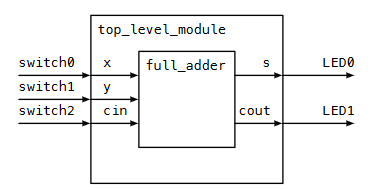
- Modules can be instantiated inside other modules
module top_level(input switch0,
input switch1,
input switch2,
output led0,
output led1
);
// instantiate the module full_adder, adder0 is his name
full_adder adder0(
.x(switch0),
.y(switch1),
.cin(switch2),
.s(led0),
.cout(led1)
);
endmodule
Wire Nets
- Wires are analogous to wires in a circuit you build by hand, they are used to transmist values between inputs and outputs, Declare wires before they are used.
wire a;
wire b;
- The wires above are scalar. They can also be vectors.
wire [7:0] c; // 8-bit wire declaration
Operators
- Arithmetic
For the FPGA, division and multiplication are very expensive and sometimes you can not synthesize division. If you use Z or X for values the result is unknown. The operations treat the values as unsigned.
If a=5, b=10, c=2'b01 and d=2'b0Z

- Bitwise
Each bit is operated, result is the size of the largest operand and the smaller operand is left extended with zeroes to the size of the bigger operand.
If a=3'b101, b=3'b110 and c=3'b01X
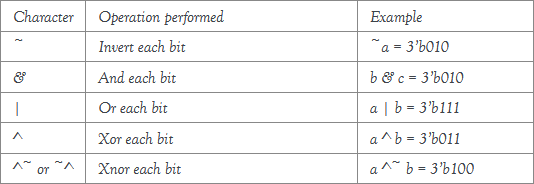
- Reduction
These operators reduces the vectors to only one bit. If there are the characters z and x the result can be a known value.
If a=5'b10101, b=4'b0011, c=3'bz00 and d=4'bx011
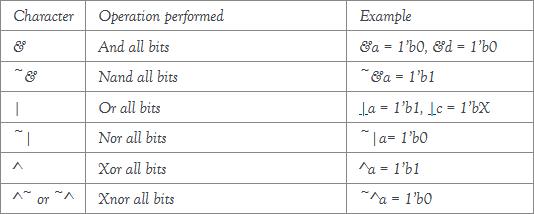
- Relational
These operators compare operands and results a 1 bit scalar boolean value. The case equality and inequality operations can be used for unknown or high impedance(x or z) and if the two operands are unknown the result is a 1.
If a=3'b010, b=3'b100, c=3'b111, d=3'b01z and e=3'b01x
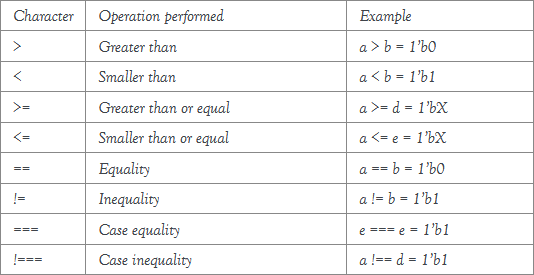
- Logical
These operators compare operands and results a 1bit scalar boolean value.
If a=3'b010 and b=3'b000

- Shift operators
These operators shift operands to the right or left, the size is kept constant, shifted bits are lost and the vector is filled with zeroes.
If a= 4'b1010 and b=4'b10x0

- Others
These are operators used for condition testing and to create vectors
If a=4'b1010 and b=4'b10x0

Operators Precedence
The order of the table tells what operation is made first, the first ones has the highest priority. The () can be used to override default.
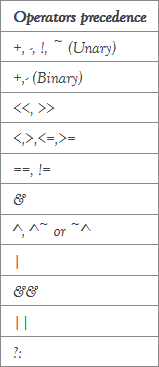
// conditional operator ?:, this example is an expression that implements min(a, 10)
wire out;
assign out = a > 10 ? 10 : a;
// if a==b then c=0
// else if a<b then c=1
// else c=2
assign c = a==b ? 2'd0 : (a<b ? 2'd1 : 2'd2);
Macros
- constants.vh:
`ifndef CONSTANTS // guard prevents header file from being included more than once, it is similar to the header file of C
`define CONSTANTS
`define ADDR_BITS 16
`define NUM_WORDS 32
`define LOG2(x) (x <= 2) ? 1 : // calculate the log2(x)
(x <= 4) ? 2 :
(x <= 8) ? 3 :
(x <= 16) ? 4 :
(x <= 32) ? 5 :
(x <= 64) ? 6 :
-1
`endif
- design.v:
`include "constant.vh"
module memory (input [`ADDR_BITS - 1 : 0] address,
output [`LOG2(`NUM_WORDS) - 1 : 0] data
);
// implementation
endmodule
Register Nets
Verilog has two types of nets: wire and reg. Reg nets are required whenever a net must preserve state(i.e. in an always block). Wires are used for structural verilog(to connect inputs to outputs) and for continuous assignment.
1.Combinational logic block
verilog allows more complex logic through the use of always blocks.
Combinational logic(i.e. no state elements) can be written using always@(*). The value inside the parentheses is called the sensitivity list. Using a * will tell the compiler to compute the sensitivity list automatically(recommended for combinational logic)
Only reg nets can be assigned in an always block
input wire a;
input wire c;
output wire b;
reg b_out;
//
always @(*)
begin
b_out = ~a;
end
assign b = b_out;
// if-else statements
always @(*)
begin
if(a)
b_out = c;
else
b_out = ~c;
end
// case statement
always @(*)
begin
case(a)
0: b_out = c;
1: b_out = ~c;
default: b_out = c;
endcase
end
WARNING:
- For and while loops can not be mapped to hardware! They are non-synthesizable control statements
- Every signal should have a default value. Assigning a value to a reg only under given conditions will result in latch synthesis. For example:
// This code will generate a latch
input [1:0] x;
reg [1:0] y;
always @(*) begin
if(x == 2'b10)
y = 2'd3;
else if(x == 2'b11)
y = 2'd2;
end
// y has a default value so that this code will not generate a latch
always @(*) begin
y = 2'b00;
if(x == 2'b10)
y = 2'd3;
else if(x == 2'b11)
y = 2'd2;
end
2.Synchronous logic block
Synchronous logic blocks are generated using special identifiers in the sensitivity list. Here we only want to update on the positive edge of the clock, so we use posedge. This will generate a synchronous circuit that implements x every clock cycle.
input clk;
reg [1:0] x;
always @(posedge clk)
begin
x <= x + 1;
end
Wire vs Reg
Rules for picking a wire or reg net type:
- If a signal needs to be assigned inside an always block, it must be declared as a reg
- If a signal is assigned using continuous assignment statement, it must be declared as a wire
- By default module input and output ports are wires; if any output ports are assigned in an always block, they must be explicitly declared as reg: output reg
How to know if a net represents a register or a wire - a wire net always represents a combinational link
- a reg net represents a wire if it is assigned in an always@(*) block
- a reg net represents a register if it is assigned in an always @(posedge/negedge clock) block
Localparam/parameter Declaration
1.localparam: Private module parameters are defined using the localparam directive. These are useful for constants that are needed only by a single local module, and it can not be instantiated with it
2.parameter: it's feature is similar to localparam, further more, it can transimit the parameter setting
For example, first define a module
module example #(parameter SIZE=7)
(input clk,
input rst_n,
output [SIZE-1 : 0] data
);
localparam K = 5;
reg [7:0] x;
always @(posedge clk or negedge rst_n)
begin
if(!rst_n)
data <= 0;
else
data <= K + x;
end
endmodule
second when to instantiate the example module in the top level, and data size is required to modified as 32-bit
example EX1
#(.SIZE(32)) // 参数例化
(
.clk(clk),
.rst_n(rst_n),
.data(data)
);
Code Generation with for-generate loops
-- wait to fill up
Multidimentional Nets in verilog
// A memory structure that has eight 32_bit elements
reg [31:0] fifo_ram [7:0];
fifo_ram[2] // represents the full 3rd 32-bit element
fifo_ram[5][7:0] // represents the lowest byte of 6th 32-bit element
Initial blocks and Testbench
`timescale 1ns/1ps
// a delay of #1 would result in a 1ns step
// Delays as low as #0.001 would be supported due to the resolution of 1ps
module tb;
reg clk_in;
reg rst_n;
wire clk_out;
reg a_in;
wire b_out;
initial
begin
clk_in = 0;
repeat (20) #10 clk_in = ~clk_in;
end
initial
begin
rst_n = 0;
#10;
rst_n = 1;
end
initial
begin
a_in = 0;
#10 a_in = 1;
#10 a_in = 0;
end
divider D1(
.clk_in(clk_in),
.clk_out(clk_out),
.rst_n(rst_n),
.a(a_in),
.b(b_out)
);
endmodule
Others
repeat (8'hff) @(posedge clk); // repeat 0xff positive edges of clk
@(posedge clk); // wait for the positive edge of clk